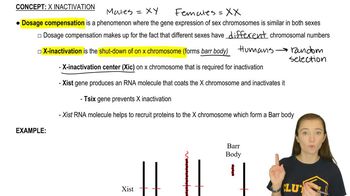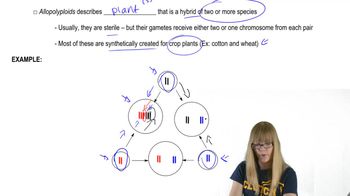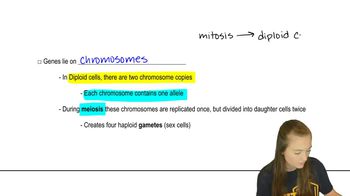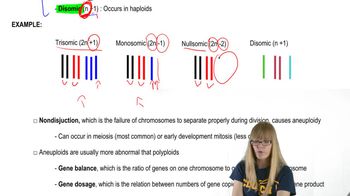Table of contents
- 1. Introduction to Genetics51m
- 2. Mendel's Laws of Inheritance3h 37m
- 3. Extensions to Mendelian Inheritance2h 41m
- 4. Genetic Mapping and Linkage2h 28m
- 5. Genetics of Bacteria and Viruses1h 21m
- 6. Chromosomal Variation1h 48m
- 7. DNA and Chromosome Structure56m
- 8. DNA Replication1h 10m
- 9. Mitosis and Meiosis1h 34m
- 10. Transcription1h 0m
- 11. Translation58m
- 12. Gene Regulation in Prokaryotes1h 19m
- 13. Gene Regulation in Eukaryotes44m
- 14. Genetic Control of Development44m
- 15. Genomes and Genomics1h 50m
- 16. Transposable Elements47m
- 17. Mutation, Repair, and Recombination1h 6m
- 18. Molecular Genetic Tools19m
- 19. Cancer Genetics29m
- 20. Quantitative Genetics1h 26m
- 21. Population Genetics50m
- 22. Evolutionary Genetics29m
6. Chromosomal Variation
Chromosomal Mutations: Aneuploidy
Problem 31c
Textbook Question
Textbook QuestionFor the following crosses, determine as accurately as possible the genotypes of each parent, the parent in whom nondisjunction occurs, and whether nondisjunction takes place in the first or second meiotic division. Both color blindness and hemophilia, a blood-clotting disorder, are X-linked recessive traits. In each case, assume the parents have normal karyotypes (see Table 10.2).
A man who is color blind and a woman who is wild type have a son with Jacob syndrome (XYY) who has hemophilia.
 Verified Solution
Verified SolutionThis video solution was recommended by our tutors as helpful for the problem above
Video duration:
2mPlay a video:
Was this helpful?
Key Concepts
Here are the essential concepts you must grasp in order to answer the question correctly.
X-linked Inheritance
X-linked inheritance refers to the pattern of inheritance for genes located on the X chromosome. In this case, color blindness and hemophilia are both X-linked recessive traits, meaning that males (who have one X and one Y chromosome) will express the trait if their single X carries the recessive allele, while females (with two X chromosomes) must have both Xs carrying the recessive allele to express the trait.
Recommended video:
Guided course

X-Inactivation
Nondisjunction
Nondisjunction is the failure of homologous chromosomes or sister chromatids to separate properly during cell division, leading to gametes with an abnormal number of chromosomes. This can occur during either the first or second meiotic division, resulting in conditions such as Jacob syndrome (XYY) when an extra Y chromosome is present, which can affect male characteristics and fertility.
Recommended video:
Guided course

Allopolyploidy
Meiotic Division
Meiotic division consists of two rounds of cell division (meiosis I and meiosis II) that produce gametes with half the number of chromosomes. In meiosis I, homologous chromosomes are separated, while in meiosis II, sister chromatids are separated. Understanding where nondisjunction occurs—whether in meiosis I or II—is crucial for determining the genetic outcomes in offspring, such as the presence of Jacob syndrome and hemophilia in this scenario.
Recommended video:
Guided course

Diploid Genetics
Related Videos
Related Practice




